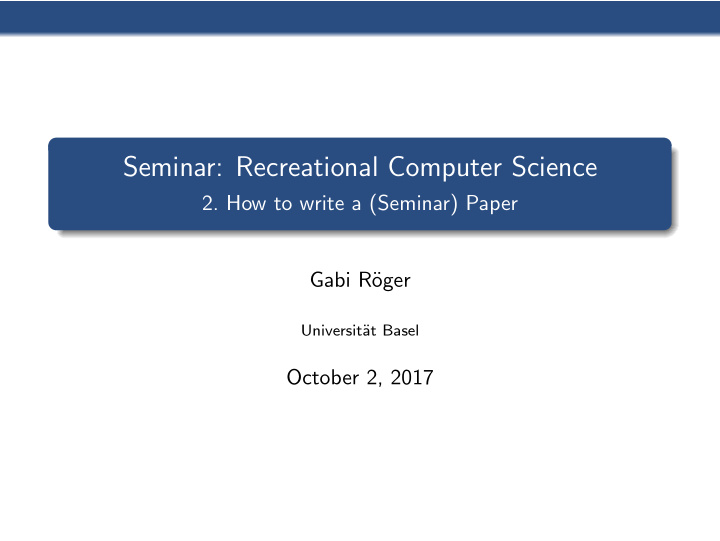



Seminar: Recreational Computer Science 2. How to write a (Seminar) Paper Gabi R¨ oger Universit¨ at Basel October 2, 2017
Getting started Structure Citation Common problems Getting started
Getting started Structure Citation Common problems Aim Other seminar participants You Who is the audience? Practice reading and What do they already writing scientific reports know? What should they learn?
Getting started Structure Citation Common problems Getting Material Finding material references in the material you already have https://scholar.google.com reference section in wikipedia articles library ask advisor for help Article only available for money? homepages of the authors university subscription library
Getting started Structure Citation Common problems Understand the Material www.xkcd.com do not ignore complicated details speak with your advisor if you need help
Getting started Structure Citation Common problems Structure
Getting started Structure Citation Common problems A Typical Structure abstract introduction background main parts related work conclusion references
Getting started Structure Citation Common problems Abstract I Sorting Algorithms Hans Meier Seminar on Algorithms and Data Structures University of Basel HS 20XX Abstract A sorting algorithm orders the elements of a list according to a given total order relation. We explain three different such algorithms, namely merge sort , heap sort and quick sort and analyse their time and space complexity. An empirical evaluation illustrates in which scenarios these algorithms have their strenghts and weaknesses. 1 Introduction
Getting started Structure Citation Common problems Abstract II very brief description of what is in the paper should help potential readers to decide whether the paper is relevant to them contains no references in L A T EX: \ begin { abstract } ... \ end { abstract }
Getting started Structure Citation Common problems Introduction setting high-level description of the topic motivation why the topic is interesting structure of the paper
Getting started Structure Citation Common problems Introduction setting high-level description of the topic motivation why the topic is interesting structure of the paper We start by introducing the SAS + planning formalism and our new framework, which is based on operator- counting constraints . Afterwards, we present a wide range of such constraints and explain how they can be used to express existing heuristics. We then prove some theoretical results on interesting connections between the heuristics and end with an experimental study and conclusions. [Pommerening et al., ICAPS 2014]
Getting started Structure Citation Common problems Background introduces basic terminology and notation builds the fundament for the main parts often general, well-known definitions or work by others papers must be self-contained, here is the place to achieve this section title not necessarily “background” e.g. Pommerening et al. [ICAPS 2014]
Getting started Structure Citation Common problems Main Parts core of the paper sub-structure depends very much on topic
Getting started Structure Citation Common problems Related Work brief description of other approaches to the same problem focus on core ideas sometimes also directly after introduction
Getting started Structure Citation Common problems Conclusion wraps up the paper short summary of main findings should not repeat the abstract or introduction often closes with open questions or an outlook to future work
Getting started Structure Citation Common problems References list of used literature should be complete and consistent do not write “Proceedings of the Xth Conference on Blabla” for one conference and “Proc. ACRONYM 2000” for another or even worse: the same conference use bibtex, biblatex, . . . read the messages of these tools warnings for incomplete entries
Getting started Structure Citation Common problems Citation
Getting started Structure Citation Common problems Citation “Meier and Huber (2013) have shown. . . ” “For the n 2 -puzzle, finding the shortest solution is NP-complete (Ratner and Warmuth 1986).” Theorem 1 (Murphy’s law, Sack 1952) . Anything that can possibly go wrong, does. not “(Meier and Huber 2013) have shown. . . ” not “In (Meier and Huber 2013) . . . ”’
Getting started Structure Citation Common problems Bibtex @Article{stewart-gallery, author = "Ian Stewart", title = "How Many Guards in the Gallery?", journal = "Scientific American", year = "1994", volume = "270", issue = "5", pages = "118--120" } (Demo)
Getting started Structure Citation Common problems Common problems
Getting started Structure Citation Common problems How to Fill the Paper? add explanations add examples
Getting started Structure Citation Common problems Common Issues Usage of terms before their introduction Only translation of original text Colloquial or imprecise language
Getting started Structure Citation Common problems Questions Questions?
Getting started Structure Citation Common problems References Pommerening, F., R¨ oger, G., Helmert, M., and Bonet, B. (2014). LP-based heuristics for cost-optimal planning. In Proc. ICAPS 2014 , pages 226–234. Ratner, D. and Warmuth, M. (1986). Finding a shortest solution for the nxn extension of the 15-puzzle is intractable. In Proc. AAAI 1986 , pages 168–172. Sack, J. (1952). The Butcher: The Ascent of Yerupaja epigraph . Rinehart & Co, inc.
Recommend
More recommend